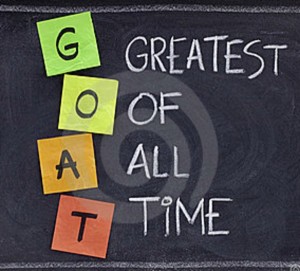About a week ago, BEFORE the outcome of the Super Bowl, I made the case against Tom Brady being the G.O.A.T. …or more specifically, against the overly simplistic criteria of Super Bowl rings so many use to come to such a conclusion. Since the Patriots’ improbable comeback, social media has been inundated with claims that it validated his G.O.A.T. status.
Even before last week’s win, Brady was well within the conversation…even if the conversation itself is inherently flawed and incomplete. Why? Consider Joe Montana’s response to the question about Tom Brady.
“I think that it’s really hard to put anyone in that bucket,” he said. “Even before he got five-you look back to some of the guys some people don’t even know, Sammy Baugh or Otto Graham, I can’t remember which one but one of them won like seven or nine championships and was so far ahead of their time. It’s so hard to compare guys from then to now, how they would compare here and how we would compare back then.”
Maybe this is merely one competitor’s refusal to surrender the mythical throne to another, but even if it is, can it be denied that he has a point?
Here is the trouble with G.O.A.T. debates: 1) they wreak with recency bias; 2) they lack consideration for era context; and 3) its participants have no way to factor in the eye test.
Why are they subject to recency bias? Because it is a natural tendency of human memory. That is precisely why those running for political office try to get the last positive idea about themselves and/or negative idea about their opponent out before the actual election. Whatever is most recent is often deemed “better” or at the very least, most reliable. This is compounded as time goes by. As hard as it might be to comprehend, in 30-40 years some very knowledgeable basketball fans will be having a G.O.A.T. debate and it will not be open and shut that such a title will go to Michael Jordan. In fact, some will not even give MJ proper consideration. As ridiculous as that sounds, trust me, it will happen.
Then there is the lack of consideration for the context of eras. Regardless of the sport, different rules and circumstances provide for different challenges. So essentially, the comparisons are next to never “apples to apples”. For example, for most of Mel Blount’s career as the best corner of the 1970s, he could literally maul receivers all over the field until 1978 when the “one chuck within 5 yards” rule was implemented. Add that to the fact that he didn’t have to cover long playing on the back end of the Steelers “Steal Curtain” defense and pass rush. So as great as he was, how does one compare him to Deion Sanders as a cover corner?
How does one compare Johnny Unitas to Tom Brady, who faced the same 11 guys on defenses that were far less sophisticated when compared to today’s defenses? But Unitas also had to use receivers that had a much more difficult time getting open then any that Brady has had. Finally, defenders could actually rough up Unitas without getting the flag that they would get today against Brady.
The differences cannot be limited to sports factors alone. Our food supplies are different, one could argue for both the better and worst of that supply, I contend has led to bigger and stronger athletes, if not necessarily better. Thus, the more recent era produced a 300+ pounder named Shaquille O’Neal. It’s often said he would have knocked Bill Russel into the second row. But would he have been 300 pounds had he come along during Russel’s era? Would Russel have been a mere 215 pounds had he come up during Shaq’s era? Unless an adjustment is made for both, it’s as a ridiculous comparison as it would be comparing the production of a secretary with a typewriter with one that has a computer. Or the closure rate of a homicide detective with DNA with one before DNA.
The last factor in the flawed GOAT debates is the lack of the eye test. This is what stat junkies fall for all the time. Statistics alone do not provide the nuance that only actually watching an athlete does. In other words, consider sports greatness the same as the Supreme Court considers pornography: you may not be able to define it, but you know it when you SEE it.
Statistically, some will make the case for Andy Petite being a viable Baseball Hall of Fame (HOF) candidate over other lefthanders such as Mickey Lolich, Dave McNally, Mike Cuellar, Vida Blue, or David Wells; none of whom are or ever will get into the HOF. I remember all five of them and trust me; Andy Petite, though a very good pitcher for many years, was not as good as any of them.
So how can we continue these flawed, but highly entertaining debates? One simple adjustment; instead of declaring who is the G.O.A.T., how about we simply limit it to the G.O.Y.T. or Greatest of Your Time? Under this banner, we are all qualified. Recency bias is not a factor, we can all speak to era context and we limit our assessment to those we have actually seen play.
Gus Griffin, for War Room Sports
Tags: All's Fair in Sports and War, Bill Russell, G.O.A.T., Greatest of All Time, Gus Griffin, Joe Montana, Michael Jordan, Super Bowl, Tom Brady, War Room Sports, WRS

